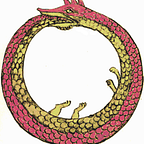THE MONK’S PARLOUR
A treatise on pseudo-gothic world building, religious brotherhood and the John Soane house.
The text below forms the written component of a self-published zine.
Until recently, on every visit I have made to John Soane’s house, the Monk’s Parlour has been closed. Tucked away downstairs, in the backmost corner of the house, hidden amongst a forest of relics and antiquities, the room sits and waits. There is a gloom that is not present in other areas of the house. The Parlour separates itself, it creates its own atmosphere. Dark wood and stone carvings form a gothic style that is at once familiar yet also unknown. It is a Soane original, unique to his house. Pseudo- or post-gothic perhaps. The only consistency with the rest of the house is the maximalism of an obsessive antiquarian.
A glass panel in the door is the only window into the life of the Monk. I peer through, wishing to be on the other side. Dimly lit, the Parlour is bathed in Soane’s characteristic yellow light. Semi-illuminated faces hung on the wall stare back at me through the glass, grotesques with twisted expressions adding to the mystery. What was this room for? And who was the Monk who called the Parlour home? I can’t answer these questions — the room is locked.
I can see no more than what is shown to me.
Upon my next visit, seemingly through complete chance, I am permitted entry into the Monk’s world.
The door leads to not one, but three rooms inhabited by the mysterious holy man.
The Parlour itself is the area I had seen from the threshold. In the middle of the room, amongst walls lined with paintings, a skylight recreates the vaulted ceiling of a cathedral. This is where the Monk prayed and studied (a desk on the right of the Parlour belonged to Robert Walpole, whose son Horace was the designer and resident of Strawberry Hill — another building of post/pseudo-gothic renown).
To the left of the Parlour, seen through a wooden casement window, is the Monk’s Cell, his living space and sleeping quarters. It is an alcove with a large triptych mirror, a 15th-century carved wood crucifix, holy water stoup and stacks of holy books.
The right side of the room is not only illuminated by a second, hidden, skylight but also by a large stained glass window of Flemish origin dating to the 16th century. Behind this window a ruined building quietly makes its presence known. It looms out there, looking in. Outside is the Monk’s Yard. The ruin is a cloister, all that remains of the monastery once inhabited by the Monk and his Pious Brothers (in fact, it comprises various 13th- and 14th-century ruins taken from the Old House of Lords and Westminster Hall).
Yet even after exploring the world of the Monk, I remain captured by the grotesques I had first seen through the window. Inside the Parlour they are everywhere; they cover the walls. Relics, mostly of medieval origin, taken from churches and gothic buildings. Grotesques and gargoyles sit alongside unknown creatures alongside model buildings alongside holy figures and demons alongside abstract shapes and carved messages. The walls teem with life, but of note there is no consistency amongst the stone ornamentation — each piece on display was born into a different world to that of its neighbours. In fact, there is no consistency anywhere in the rooms of the Monk. They are home to objects from different times, different styles, and of varying authenticity.
This fallacy spreads beyond the objects in the room. Even the Monk is a lie. Named Padre Giovanni, The Monk was a character who occupied Soane’s mind and his house. That Soane shared his name with Padre Giovanni (Father John) points to a personal connection with his Monk, which is exemplified in his journals. The Holy Man first appears after the death of Soane’s wife in 1815; from this point on the widowed architect refers to his office as his own “Monk’s Cell”. A sombre origin pertains to the atmosphere Soane has created in the Monk’s suite of rooms, but in the Parlour the gloom is ornamental. Soane is not sharing his grief, or making a guest experience it. The private side of the Monk, deeply rooted in Soane’s own psyche, is not on display in this space. What is outwardly expressed by Soane may be rooted in tragedy but is explicitly nonsensical. Soane himself commented on the rooms: “Dulce est desipere in loco”.
It is delightful to play the fool occasionally.
The Monk occupies a space that is not of our time or of our world; he is an illusion of antiquity. Yet it does not matter that his belongings are mismatched in origin because they are tonally matched; when placed together in a room they transcend the need for academic organisation. They instead tell a story and create a world despite their own stories being inconsistent with each other. This world building is a skill Soane seems to have in abundance. The whole of the Soane House is a world separate from, and hidden to, the London outside. He created these rooms and housed these objects within. All are somehow connected to Soane; together they create the otherworldly feeling of the house. The world he has built is a facsimile of himself, a Soane-ian landscape. And, if you venture into the house, straying further from your own reality and the world you know, the Monk’s world lies there waiting, in the depths of Soane’s mind.
